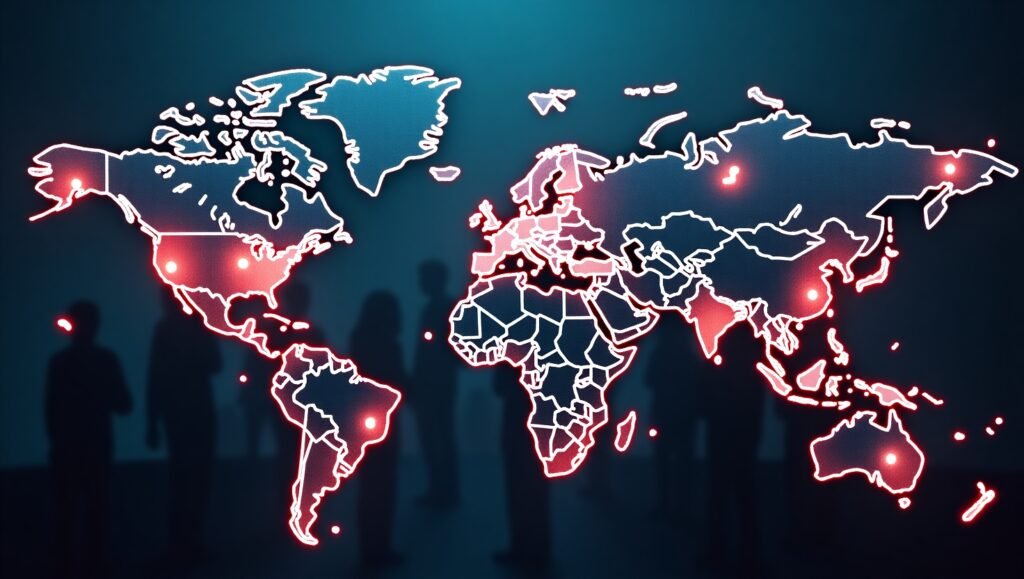|
Getting your Trinity Audio player ready...
|
Sexual slavery, a brutal and concealed dimension of human trafficking, remains one of the most profitable and pervasive crimes worldwide. Hidden in plain sight yet systematically ignored in boardrooms, legislative chambers, and even mainstream media, the commercial sex industry fuels a billion-dollar underground economy. Beneath this financial facade lies an industrial-scale violation of human rights, where women and girls—often teenagers or even children—are lured, trapped, and sold across borders. This article exposes how the machinery works, who’s profiting, who’s suffering, and what’s being done—if anything—to stop it.
Countries Most Vulnerable to Sexual Slavery
While no country is immune, certain regions suffer disproportionately from sexual slavery due to political instability, poverty, gender discrimination, and corruption. Southeast Asia leads with countries like Thailand, Cambodia, and the Philippines being both sources and destinations. In Africa, Nigeria and the Democratic Republic of Congo are primary origin points. In Europe, Romania, Moldova, and Ukraine are often origin countries for victims trafficked to Western nations.
Routes of Trafficking
Victims are trafficked from Eastern Europe to Western Europe, from Sub-Saharan Africa to North Africa and the Middle East, and from South Asia to the Gulf States. Latin America, especially Venezuela and Colombia, has become a key corridor into North America. In every case, the common denominator is vulnerability—economic despair, social isolation, and institutional failure.
How Criminal Syndicates Lure Their Victims
The recruitment phase is the most psychologically insidious component of sexual slavery. Traffickers identify vulnerabilities—economic hardship, family dysfunction, lack of education—and exploit them with precision. Young girls are frequently targeted in rural areas or impoverished urban communities where opportunities are scarce and desperation is high. These criminal organizations do not need to rely on physical force at first; manipulation, deceit, and emotional dependency do the work. Once trust is established, the descent into exploitation is swift and brutal.
The Lover Boy Scheme
Criminal networks employ psychological warfare. In one of the most common scams, the so-called “lover boy” approach, traffickers feign romantic interest, showering young girls with affection and promises of a new life—often abroad. Once emotionally bonded, the victims are manipulated into traveling, only to find themselves imprisoned in brothels or apartments with their passports confiscated.
Fake Jobs, Real Nightmares
Job advertisements for waitressing, modeling, or hotel work are often bait. Desperate for a better life, young women fall into the trap. Once abroad, the offers disappear, and the nightmare begins. Traffickers tell them they owe thousands in travel or visa fees. The price? Selling their bodies—sometimes up to 20 times a day.
The Digital Marketplace
The internet has become a trafficking supermarket. Recruiters use social media, messaging apps, and even dating platforms to identify, groom, and trap victims. Girls as young as 12 are targeted with messages that sound like salvation but end in exploitation.

The Mechanics of the Sex Trade
At the core of the commercial sex industry lies a highly structured, profit-driven system designed to exploit human bodies as commodities. This machinery is operated by complex criminal syndicates that handle recruitment, transport, control, and profit distribution. From street-level pimps to international trafficking networks, the trade is fueled by relentless demand and protected by corruption and social indifference. Understanding the mechanics of this illicit economy is essential to dismantling the chains that bind victims to their captors.
Brothels, Hotels, and Private Homes
Victims are distributed across venues—from seedy motels to high-end apartments—where clients often pay thousands while the women earn nothing. Many are drugged or beaten into submission. They are watched constantly and threatened with violence against their families if they try to escape.
No Payday for the Enslaved
Most victims receive no payment. Instead, they are kept in debt bondage—a cycle of fake loans, inflated service costs, and constant threats. Even in high-end prostitution rings, victims may see only a few dollars of what clients pay. The rest goes to pimps, corrupt police, or trafficking bosses.
Exported Like Commodities
Sexual slavery is a transnational business. Victims from Romania are found in Germany and the UK. Nigerian girls are trafficked to Italy, Libya, and Saudi Arabia. Nepali and Bangladeshi women end up in the brothels of India and the Gulf. These women are moved like contraband, documented with forged papers or none at all.
Institutional Response: Too Little, Too Late
The institutional response to sexual slavery has long been marked by inertia, inconsistency, and inadequate coordination. Despite growing awareness, a global strategy remains elusive. Bureaucratic fragmentation, political hesitance, and limited cross-border collaboration have allowed criminal networks to exploit legal loopholes and remain one step ahead of enforcement agencies. While some governments are increasing their efforts, the majority still lack the infrastructure or political will to prioritize the dismantling of trafficking rings or the long-term care of survivors.
Democratic Governments Wake Up—Slowly
The U.S., UK, and EU have increased funding for anti-trafficking units and passed legislation allowing stiffer penalties. However, prosecutions remain rare. In many cases, victims are criminalized instead of rescued. Shelters are underfunded. Witness protection is weak. And border authorities often fail to spot victims in transit.
Origin Countries Counter-attack: Fighting a Losing Battle
Countries like Moldova and Nigeria have launched education initiatives and awareness campaigns aimed at curbing human trafficking, but these efforts often falter against deeply rooted corruption and chronically underfunded institutions. In many instances, law enforcement agencies are either overwhelmed or complicit, allowing traffickers to operate with impunity. For survivors, access to psychological care, legal aid, or vocational reintegration is minimal or nonexistent—leaving many vulnerable to re-exploitation or retrafficking in a system that offers them no real path to recovery.
A Call for Accountability and Action
Sexual slavery isn’t a fringe issue—it’s systemic. It thrives where institutions are weak, where women are second-class citizens, and where profits blind justice. As consumers, citizens, and humans, we must ask: who is benefiting? And who is being sold to pay the price?
To break this chain, we need harsher global laws, massive investments in victim rehabilitation, tech regulation to monitor recruitment platforms, and a fundamental societal shift in how we view sex work, consent, and women’s rights.
We will continue to investigate this critical issue. Check back with us daily as we expand this series, name the networks, and follow the money. And please—leave a comment below. Your voice matters. Your outrage matters. And your awareness can save lives.










Let’s STOP the trafficking in the world!